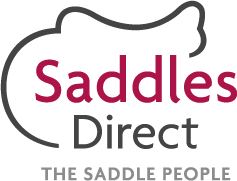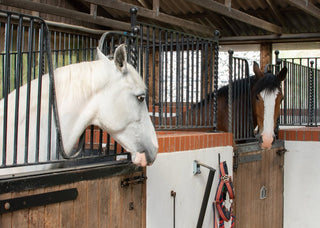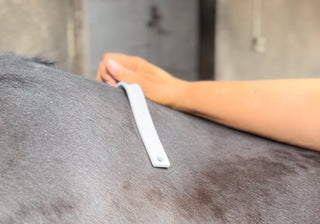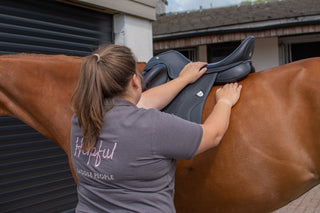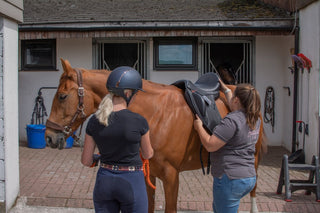Having a horse which is resistant or unhappy about being girthed when tacking up is a common problem for many horse owners. Horses experiencing girth related problems, often described as ‘girthiness’ can present with a variety of symptoms both physical and psychological.
The common signs of Girth Aversion/Girthiness include:
-
biting or kicking when saddled up
-
showing girth sores or rubs
-
missing hair behind the elbow and at the girth area
-
a decreased stride length when being ridden
There can often be no obvious cause or reason to certain horses being ‘girth avert’ and sometimes the horse will have seemingly always have been that way, whereas others may develop the behaviour. Typically horses can become ‘girthy’ as a result of a previous trauma, as a reflection of digestive discomfort or in many cases girth related problems can stem from poorly fitting tack.
In terms of managing the problem, it is not helpful to punish your horse for his ‘girthy’ behaviour. A horse resistant to being girthed is likely to have a heightened sense of anxiety or fear to an experience they find unpleasant, so punishing this behaviour simply reinforces that saddling up is something for the horse to fear or fight. Instead, horse owners need to identify, manage and limit potential causes in order to get to the root of the problem and create a permanent solution.
Here's our guide to managing Girthiness in horses:
Assess whether the saddle is a good fit.
The horse may be reacting to the girthing process because the saddle is causing pain. Make sure that the saddle fits properly, ensuring it is not restricting the withers or the shoulder and that it is the correct length for the horse. It is essential that the gullet provides sufficient clearance for the spinal processes and that the saddle is placed in an accurate, correct position on the back.
Girth Comfort.
The comfort of the girth is crucial, especially for those sensitive equines. Selecting a girth which suits the horse can take time and effort but finding the ‘one’ can revolutionise the horse. The design of girths on the market have become significantly more innovative and a range of ergonomically designed girths include features such as anatomical shaping, elasticated panels, fur lined girths or girth sleeves to name just a few. Apart from the obvious avoiding of rubs or girth galls when choosing a girth for a ‘girthy’ horse, is essential to ensure the girth does not interfere with the equine’s movement. In addition it may be wise to bear in mind that a wider girth may be more comfortable as an increased width will dissipate pressure across a larger surface area.
Girth Fit.
The girth should be tight enough to hold your saddle in place, but not so tight that it restricts the horse’s breathing or movement. Remember a girth needs to be only tight enough to provide a secure platform for riding. Cranking a girth up an extra hole just because you have the muscle power is unnecessary and can damage the horse’s pectoral muscles. Likewise if it’s too loose, the girth is liable to rub or pinch. We advised people to avoid girths with elastic on just one side – they put uneven pressure on the horse and can also affect the fit of the saddle by pulling it to one side. In some cases prolonged use of a one-sided elastic girth has lead to a twisted tree!
Girth Application.
When dealing with a horse that is ‘girthy’ the way in which horse owners apply the girth is crucial. Tightening the girth one hole at a time, gradually, whilst giving the horse time to relax between adjustments is ideal. It can be advisable to walk the horse a few steps between girth adjustments. After the girth has been tightened simply pull the horse’s front legs forward in order to smooth the skin under and around the girth area.
Girth Hygiene.
It may seem obvious but keeping your horse’s girth clean is important. Wiping down the girth after use will ensure it does not retain any sand, grit, dirt or debris and a regular clean will remove sweat and air which can exacerbate girth rubs or sores.
Everyone has their favourite girths but at Saddles Direct, we really see the benefits of anatomical girths. The shape is forward cut for added comfort and it really helps to prevent the saddle from moving forwards. We also rate the neoprene girths made by Kieffer and Schockemohle, they are hard wearing girths that wick away moisture to help prevent rubs and sores. They are also machine washable and well padded making them ideal for sensitive horses!
If you're worried that girthiness might be caused by the saddle, it's always best to call a saddle fitter. Often when riders reach out, they already suspect that something is not quite right. It’s a gut feeling, an intuition built on the bond between horse and rider.
It’s always right to ask, to seek advice. Asking is always OK and costs nothing, we are here to help in our office for all things saddles, giving advice over the phone and email.
